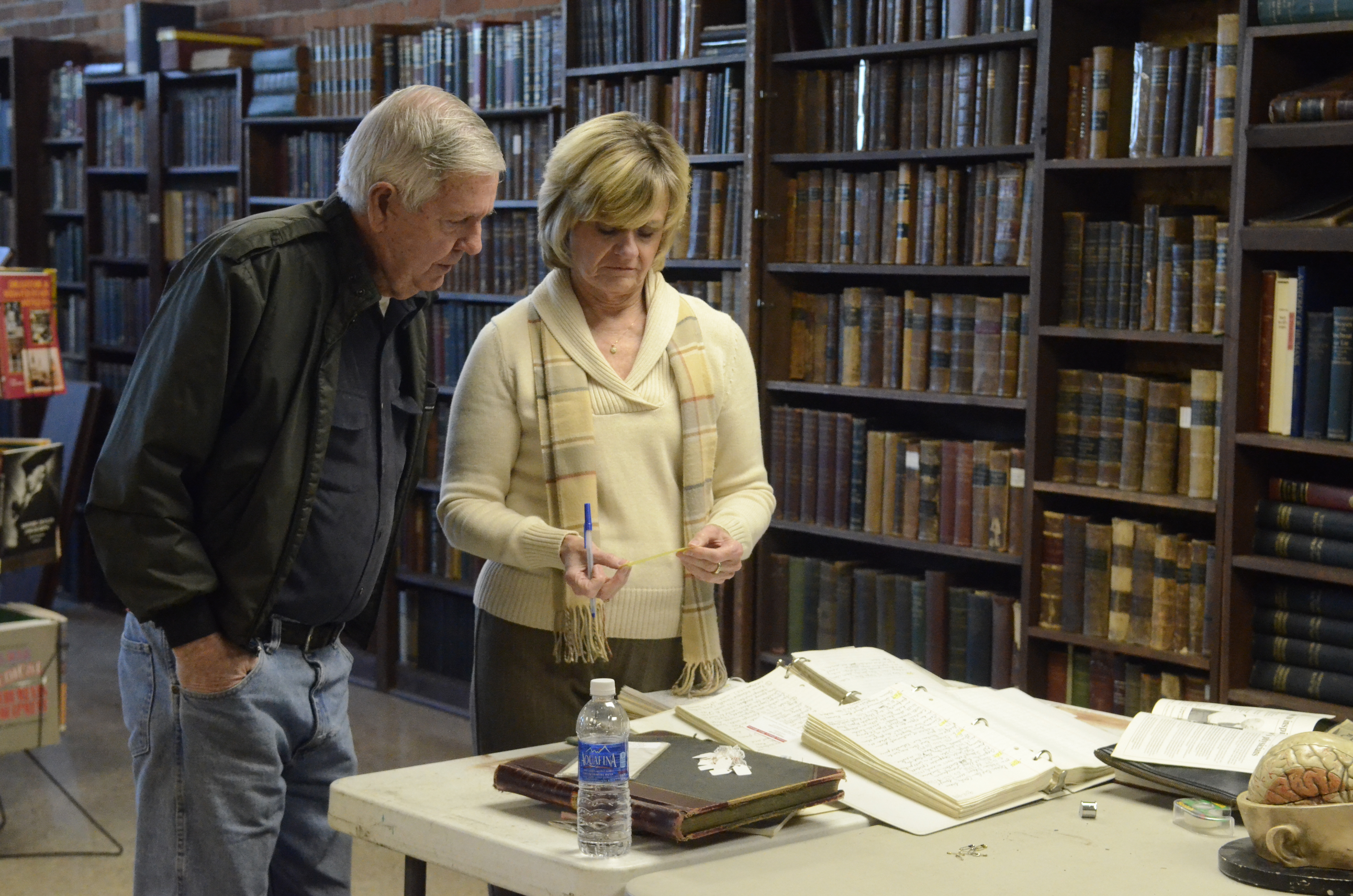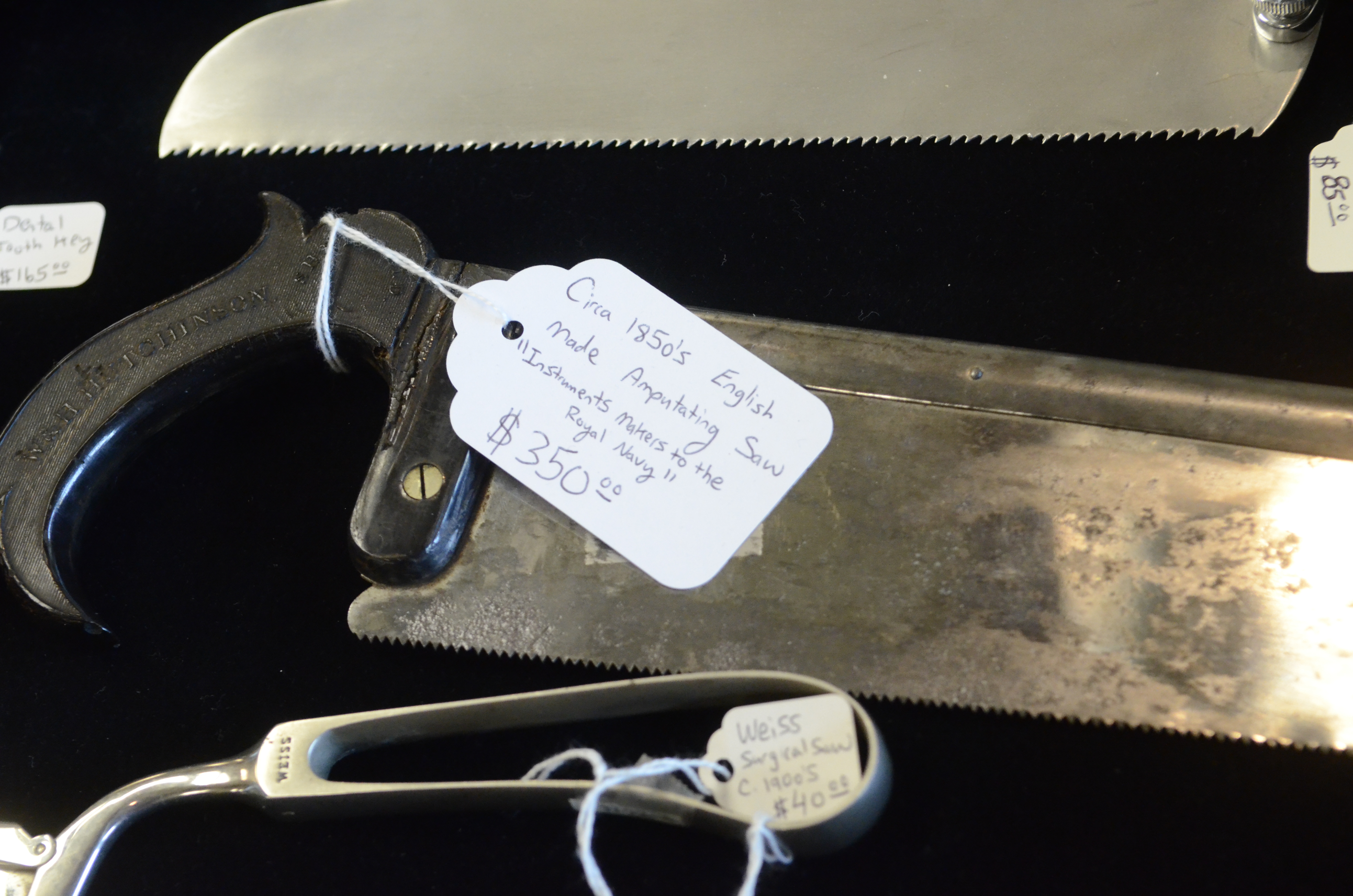Collection's 10,000 medical items up for sale (with video)
Friday, January 1, 1904
IF YOU GO* What: Estate sale of the medical collection of Dr. William Campbell.* Where: 1500 Chestnut St., corner of Chestnut and Main streets, diagonally across from T-Bones restaurant.* When: Saturday, Feb. 16, through Tuesday, Feb. 19; 8 a.m. to 4 p.m. each day with the exception of Sunday, when hours will be noon to 4 p.m.* Sale terms: Cash, check and credit cards accepted; all sales final.* Information: www.blairsestatesales.comTOP FINDSJim Blair and son, Justin Blair, owners of Blair's Estate Sales, picked their five favorite items in the collection.1. Roman surgical instruments dated 100 B.C. to 100 A.D.2. Late 1880s, oak, glass-front medical cabinet with six swing-out shelves to hold surgical implements as well as five pull-out drawers.3. Class portrait from Atlanta College of Physicians and Surgeons, which only existed under that name from 1898-1913. It is now Emory University School of Medicine.4. Civil War amputation set containing saws, knives and tourniquet clamp encased in blue velvet-lined wooden box.5. Oak table used as a set prop in the 1994 movie "Oldest Living Confederate Widow Tells All."HIGHLIGHTS OF THE COLLECTION* Surgical Instruments: Amputation saws from the 1770s to 1890s, bullet extraction forceps, dental tooth keys from 1830s to 1870s, postmortem hammers and hooks, early scalpels.* Cased Instruments: 70-piece surgical kit, circa 1870s; Civil War surgeon's kit, with original provenance; 10 cased amputation sets; Civil War era autopsy kit; 1880s 50-piece surgical amputory kit; World War I pocket surgical kit; World War II pocket sterilizing kit; transfusion kit; several 1800s enema pump kits; 1880s OB-GYN kit.* Furniture: Oak exam table, iron apothecary cabinet, 1880s oak pharmaceutical cabinet, oak and mahogany barrister bookcases, two 1890s convertible chair/exam tables, five early-1900s cast-iron footed medical cabinets, straw-stuffed operating table, 1904 oak X-ray machine, 1870s French convertible operating chair, antique wheelchairs* Books: Nearly 3,000 volumes, including embossed, velum-bound books; 1616 medical text written in Latin; 1543 medical text written in French; 1865 first-edition Civil War book on military surgery by Dr. Frank Hastings Hamilton; early Gray's Anatomy volumes.* Apothecary: Variety of glass bottles and jars ranging from reproductions to Limoges china, bronze/pewter/porcelain mortar and pestles, pharmacy scales, 1870s pill roller, leech jars, poison bottles, patent medicines, vaporizers and atomizers.* Miscellaneous: Porcelain/glass/tin medical signs, diplomas and doctoral certificates, navy wool nurse's cape from Knoxville General Hospital, collection of bed pans that includes a porcelain pan with tortoise-shell finish, 1800s anatomical charts, blood-letting bowls, four early-1900s stereoscopes and cards, antique wooden splints, 1890 polygraph machine, radiology X-ray tubes, early medical saddle bags, Red Cross medical collectibles.Source: Blair's Estate SalesPROVENANCEAnyone who has ever watched an episode of "Antiques Roadshow" knows that provenance (documention of an item's history) can make or break a sale's price. The late doctor meticulously numbered and logged every item he purchased. Several three-ring notebooks, pictured above, are filled with the doctor's handwritten notes about where items were purchased, their cost and purpose. Buyers at the sale will be able to learn the background on their purchases from these records.
Exploring several centuries of medical history was a surefire way for the young Karen LaGraff to cure a dull day.
Her uncle, the late Dr. William O. Campbell, spent four decades scouring the Internet and yard sales for medical memorabilia. He ended up with about 10,000 items.
"He used to take family and friends down into the basement beneath his house to see the collection," she recalls. "It was like a little maze -- you'd go through narrow passages with stuff piled floor to ceiling on both sides. And he always had a funny story on just about everything he'd show you."
Now those centuries of medical history are up for sale.
The Campbell family is holding a four-day estate sale beginning Feb. 16 in a 6,000-square-foot warehouse in the Southside. Most of the items are from the 16th century forward, and prices for the items range from $2 to several thousand dollars.
The Campbell collection is a rare chronology of medical and scientific history that presents tried-and-true treatments right alongside quack remedies (radium water, anyone?) The sale is notable not only for its size, but for the rarity of many of Campbell's acquisitions, and it has drawn interest from dealers across the country.
"This is by far the largest, most impressive sale I've handled in my 30 years in business. I'd have to say it's one of the most significant private collections in the country," says Jim Blair of Blair's Estate Sales, which is managing the estate sale.
"There is an American Indian medicine bag and medicine sticks; apothecary jars worth hundreds of dollars, surgical instruments dating back to the Romans," he says.
It wasn't until the doctor passed away in December 2012 that his family truly discovered what an extensive collection he had accumulated. Items were packed into the basement, as well as the home's double garage, a storage area above the garage and an outbuilding built on the property to help hold the overflow.
Civil War amputation kits, doctor's office furnishings from the 1800s and an assortment of exam tables from the 19th and 20th centuries shared space with rare medical journals, anatomical charts and even a real human skeleton.
"My brother was quite a character," says Don Campbell of Blue Ridge, Ga.
THE COLLECTOR
William Campbell was a general practitioner in the Copperhill/Ducktown area of Polk County, where he grew up in a family of six children, according to LaGraff.
In 1977, the doctor moved with wife Reba and son Martin to Chattanooga, where he became a staff physician for TVA until his retirement in 1994.
"Being a doctor was all he ever thought about doing," his brother says. "He had his appendix removed by a cousin, who was a doctor, when he was 9 years old and he kept it. But he really got hooked (on collecting) when he was 10 years old and had a real skeleton given to him.
"He and his wife would go out most every weekend to flea markets and estate sales looking for items for his collection," Don Campbell says.
Ken Rush, director of the Ducktown Basin Museum in Ducktown, Tenn., says some of the collection is being donated to the museum by the Campbell family.
"We'll be receiving portions of it that are 'from the basin,'" he says. "These include items from the old Tennessee Copper Co. hospital, items from doctors who worked for companies and clinics here in the basin. The idea is that anything that is local to this region of Southeast Tennesse will be coming to the museum."
Rush recalls the late doctor's zest for collecting and his dry humor.
"He was always looking for local items but was interested in any medical device he could run across. When he'd come back to the basin, he would generally bring one of his newer acquisitions to show us -- volunteer to use it on us if we were willing," he says, laughing.
That sense of humor is evident is a printed sign the late doctor posted alongside a full suit of armor, which is among the sale items. It advises: "Prepare for the slings and arrows of malpractice litigation."
National interest
Justin Blair says he took calls from collectors in six states in a single day last week. A medical equipment dealer from Seattle has notified the Blairs she will attend the sale, while a staff member from Dittrick Medical History Center and Museum at Case Western Reserve University in Cleveland, Ohio, also has called. The sale's website has received more than 15,000 hits.
A book dealer in Los Angeles called about buying all 3,000 volumes available in the sale -- sight unseen. He was turned down because the items had already been advertised to the public.
The Blairs also received an inquiry from the Society of Civil War Surgeons, an international organization of more than 400 members devoted to medical history education. After that call, an email blast was sent to its membership telling them of the sale, which resulted in 1,500 new views on Civil War items the following day.
"Dr. Campbell had unbelievable things!" exclaimed Mary Stacy of Atlanta in a phone interview. "I went to his house and it was astounding. He was so knowledgable."
Stacy worked as a set designer with the set decoration department on the 1994 TV miniseries "The Oldest Living Confederate Widow Tells All."
Having met the doctor at an Atlanta antiques show, she was familiar with his collection and referred the production company to him for help. The movie company not only rented pieces of his collection for its sets, the doctor also advised them on proper setup, she says.
That authenticity helped the show win an Emmy Award for art direction, she recalls.



